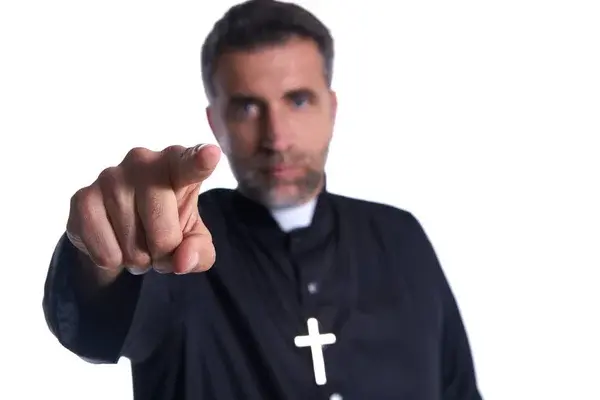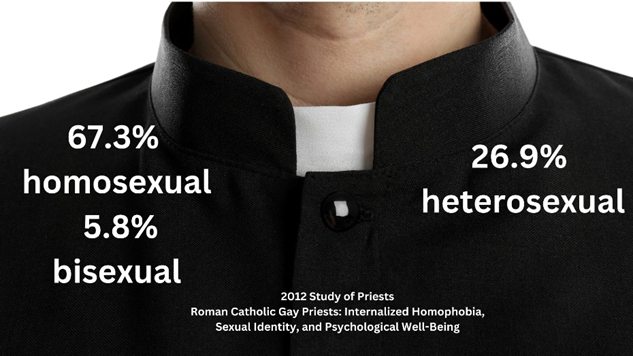
By Vicki Yamasaki
My mother often imparted the wisdom that solely accusing others points scrutiny back at oneself. I heard a priest suggest that the reason there is a shortfall of priests is directly because of laity’s tepidness. The attribution of the decline in priesthood solely to the laity is puzzling. It suggests that the laity’s indifference, perhaps their scant prayers, and their smaller families are deterring young men from the priesthood is the primary source of young men not entering the priesthood. While this may be a symptom of the problem is this truly the crux of the matter? I am compelled to unearth the fundamental causes of problems. I have an aversion to cursory explanations that overlook the necessity of data to unravel the potential underlying events of the era.
The data referenced below originates from the Center for Applied Research in the Apostolate (CARA). CUP has crafted from CARA’s data the following graphical depiction:

As we can see, the decline in the priesthood began to dramatically drop in 1985 and has continued all the way into 2022 (the latest available data).
As a very wise prominent theologian pointed out when I was perplexed by the trending year-to-year numbers: “the lavender takeover of the seminaries was in full swing by the mid-eighties and good seminarians were dismissed.”
In seminaries homosexual cliques arose mainly because some seminary rectors—in the permissive atmosphere of the times—adopted what one professor called an “ecclesiastical don’t ask, don’t tell” policy with regard to homosexuality.
The peak of the homosexuals going into the seminaries were in the 1970’s and the early 1980’s and this is also when we saw the rise in sexual abuse cases. If we look at the serial sex abuse cases that emerged by 2002 it makes sense. Because of the deep trauma, on average it takes a victim 20 years to come to terms with their abuse and come forward and name their accuser.
What follows is the testimony of Fr. Kalchik, a victim of sexual abuse after he entered into the seminary:
“I entered the Seminary in 1979. I was raped by a priest at work, during the course of a night shift as an orderly. It was reported by me to the chancellery the day it happened. Not one thing was done by [Cardinal] Bernardin. Nor anyone else in Chicago. When evil is ignored, gaslighted, you quickly learn to keep it to yourself. After attempting to get justice, I left the seminary, and worked for over a decade. And did not share anything of what happened to me with anyone. As I learned the boys in charge didn’t care, and were all complicit.”
As another courageous priest shared with me this week:
“By the 1980s, seminaries were nearly empty. It only took 10 years (1970-1980) for the Novus Ordo priesthood to show that it was not the hardcore priesthood of the saints. … I remember meeting ex seminarians in the 80s and 90s … They were like POWs … Didn’t want to talk about it, twitchy, PTSD’ish “
Commenting with anonymity, a very wise and learned devout Catholic father and fighter for holy priests shared:
“Good priests discouraged, abuser/gay priests disgraced, no call to heroic sacrifice that inspires young men of quality, and no transcendental beauty to sustain those that are recruited.”
As the homosexual scourge was making its way through the priesthood in the 70s and early 80’s we saw a marked decline in reverence from priests at this time as well. The decline in reverence was due to another root cause that I will explain in my next major section … the application of Vatican II.
Let us recall that by 1985 the WWII generation of priests were retiring, and they did not have fine traditional young men to replace them. By 1980 14% of priests were retiring. By 2020, 34% were retiring (Source The Pillar):

The Homosexual Scourge … Latest Decade
Pope Benedict XVI issued an instruction in 2005 to seminary rectors and bishops guiding them in admissions of seminarians that they “cannot admit to the seminary or Holy Orders those who practice homosexuality, present deep-seated homosexual tendencies, or support the so-called gay culture.” Despite this, the gay subculture in the priesthood seems to be thriving.
As Gene Gomulka’s research points out from “A 2012 psychological study of “actively ministering or retired priests” in the U.S. revealed that only 26.9% of the priests identified themselves as heterosexuals; 67.3% self-identified as gay/homosexual; and 5.8% reported that they were bisexual. This study, viewed in relation to previous studies, shows how the percentage of gay clergy has risen considerably over the past decades.

Where is the Growth?
Now let us look at another snapshot of data taken from 1930 to the present:
SOURCE: CARA
It’s noteworthy that the priesthood experienced a significant surge, with over 80% growth following World War II. While it’s unrealistic to anticipate a repeat of such a pronounced increase from an extraordinary era, the two decades from 1930 to 1950 were marked by expansion. The growth continued, albeit at a slower pace, with a 16% increase in the number of priests from 1950 to 1965. However, a dramatic shift occurred post-1965, coinciding with the Second Vatican Council (Vatican II). Post-implementation of Vatican II, the priesthood saw a mere 1% growth from 1965 to 1970, and subsequently, numbers began to dwindle after 1970. It’s important to recognize that seminarians in training during the Council were ordained between 1965 and 1970. The announcement of changes in 1964 likely influenced many young men’s decisions against entering the priesthood, initiating a gradual decline and reversing the previously significant growth.
Vatican II, spanning from 1962 to 1965, brought profound transformations to the Catholic Church’s structures and practices. A notable alteration was the liturgical revision. On November 29, 1964, one year after the Constitution on the Sacred Liturgy took effect, the Novus Ordo, or “New Mass,” was introduced in U.S. parishes. This event signaled a shift towards modernity, with priests now facing the congregation and embracing contemporary practices. This transition led to the abandonment of the churches’ once-transcendent beauty and sacred music, which had fostered a sense of reverence. While some Novus Ordo parishes continue to offer the sacred Mass with due reverence, their numbers are dwindling. The removal of the sacred from the apex of worship carries repercussions. Additionally, the emergence of new theological schools of thought including those that are issued from the Magisterium, cautioned against by Pope St. Pius X, poses ongoing challenges to Catholic doctrine and Sacred Scripture, threatening to overturn long-held beliefs. These practices and schools of thought from hierarchy dissuade young men from the priestly life.
Can the Laity Do it All?
There are articles like the recent First Things piece that would suggest that laity are the solution to all of the Church’s woes. While the laity will save the Church as Archbishop Fulton Sheen prophesied, they cannot be the panacea to all. He meant that we help bishops and priests to be accountable so that they act like bishops, act like priests, and act like religious.
We need priests who are traditional, heterosexual, and orthodox that defend Catholic doctrine and the entirety of Sacred Scripture. We need them to be:
- Fearless defenders against the tyranny of Marxism, socialism, and movements that indoctrinate children.
- Crusaders against the homosexual scourge within the priesthood and our nation!
- The Voice for the voiceless … the unborn.
- Protectors of the sanctity of marriage between one man and one woman
- Preservers of Natural Law
- Defenders of religious liberties because one day the U.S. government may be coming for the Catholic Church.
It certainly feels like “Early Christian” times where Catholics, Christians, families, children and prolifers are suffering greatly.
We respectfully ask the priests to please be Jesus’ apostles for these unprecedented times. We need you. We are praying for you. If not now, then when? You have the ability to change the priestly decline and heterodoxy. The power has been given to you by God Almighty. Please we ask you to make it happen.
We believe that if every one of you came together and discussed these topics during homilies, including inspiring young men in seminaries to stay on the righteous path, the Church would be transformed. If everyone stood united, no bishop would have the power to silence you, as they would have to silence every single one of you.
What will it take to grow the priesthood?
Our Lady watches over priests, cherishing those who have pledged to serve her Son faithfully. The latest generation of priests and seminarians are displaying positive signs of adherence to orthodoxy. The question remains: can they resist the pressure to conform to the modernistic beliefs of the established clergy? Will they go against the current, steering clear of the harmful subculture that beckons them? Only time will reveal the outcome. Please keep seminarians and priests in your prayers. Ask Our Lady to empower and guide them, shielding their journey under her protective care. These priests are essential. May God’s love guide them and lead back those who have strayed from God’s path, dear Lord.
